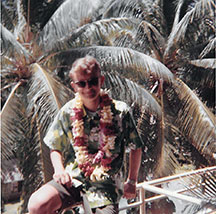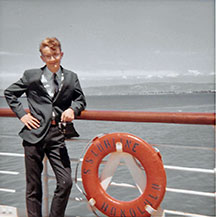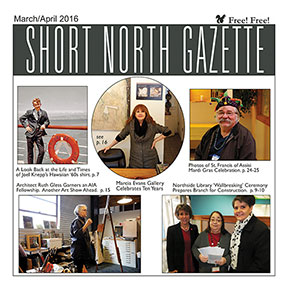
Columbus, Ohio USA
Return to Homepage www.shortnorth.com
My Hawaiian Shirt
By Joel Knepp
March/April 2016 Issue
Return to Homepage
Return to Knepp Page
The other day I decided to clean my ceiling fan, something I only remember to do when I look up and see a grey fringe on the edges of the blades. Reaching into the rag bag, I pulled out a piece of personal history that brought forth a rush of happy thoughts. In my hand was a faded section of my first and finest Hawaiian shirt.
The rag took me back some 50 years. My dad was in the U.S. Army, and one day when I was a kid he came home to our quarters in Fort Knox, Kentucky with “orders,” a pile of official papers indicating our new home would be Camp Zama, Japan. I was accustomed to moving, having previously lived in Germany, Maryland, and Massachusetts, but Japan was an exotic and largely unknown entity back then. As the months passed and plans coalesced, I learned that my parents and I would drive to San Francisco, lay over for a few days, and sail on two different ships to Yokohama, Japan via Honolulu. To add to the excitement and stress, I had to accelerate my schoolwork because we were leaving about a month before the end of my sophomore year in high school.
At last, the time came in May when we packed up everything, stored most of our household goods, and hit the road in our 1962 off-white, four-on-the-tree Mercedes 220-S with red leather seats and seat belts (!) that we had picked up at the factory in Stuttgart, Germany (another story). This was my first trip to the American West and I loved every minute of it. Early on, we saw the still-unfinished St. Louis Gateway Arch. Several days later we were motoring through some God-forsaken area of either Nevada or Utah and I demanded we stop the car so I could run out onto the perfectly white sand. When I left the road, I sank up to my ankles not in sand but in some kind of naturally occurring chemical goop that rotted out my cheap tennis shoes in about three days. The pioneers must have loved that stuff.
After further adventures, including a visit to an early McDonald’s that served tacos as well as burgers, we hit San Francisco and checked into transit quarters in Fort Mason. This was a tiny army base with stunning views of the city, the Golden Gate Bridge, and the bay; the military always grabs the best real estate. Unbeknownst to me, an ignorant child, the Hippies were starting to do their psychedelic, free-love thing just a few miles away in Haight-Ashbury. I have strongly regretted my failure to make that scene, just as I regret turning down an invitation to Woodstock three years later. Anyway, we deposited the Benz at a pier in Oakland and boarded the legendary SS Lurline, the pride of the now-defunct Matson Lines passenger service, for the first ocean leg of our journey to the Far East. The Lurline and her sister ships plied the San Francisco-Honolulu-Los Angeles triangle for decades carrying many a tourist happily engaged with hula classes, umbrella drinks, and floor shows.
Travel in the ‘60s was different than today. Ships were actually used as transportation from continent to continent rather than as travelling buffets, malls, and casinos as with today’s cruise lines. Say what you will about the military, but they treated us right when transporting us to the far ends of the earth. At least as far as Hawaii, anyway.
It was on the Lurline that I spotted my shirt, hanging in the pricey gift shop. It was the most beautiful piece of clothing I had ever seen, made of lustrous, soft cotton of a quality far finer than I had ever encountered in the post exchange (army department store) or anywhere else. The design was an almost abstract floral and leaf print in rich greens, white, and some touches of iridescent blue. The buttons were brass-colored metal with some kind of primitive archeological design. The total effect was stunning – bold yet tasteful. What more could a 15-year old with pretentions to sartorial splendor ask of a garment? I think I paid $20, which was an outrageous price for a shirt at the time and consumed many weeks of allowance. It was the best twenty bucks I ever spent.
I wore that shirt proudly throughout the five-day Lurline journey and during our all-too-brief 24-hour stay in Honolulu. Somewhere there is a photo of me wearing it on a Waikiki hotel balcony surrounded by palm trees. I wore my shirt a few times on the wretched military ship that took 11 days to get us from Hawaii to Japan. It was donned on select occasions throughout my junior and senior years of high school on the army base. Discerning individuals admired my shirt and said so. It was especially popular among the Japanese, who love all things Hawaiian. When it came time to travel back to America for college, this time by jet plane, the shirt came with me.
In the ‘60s and early ‘70s, Hawaiian aka aloha shirts were known entities but certainly weren’t ubiquitous as now. At college, most of us wore denim, plaid cotton flannel, and perhaps on certain occasions big-collared dress shirts with fat ties. Almost nobody I knew had a real Hawaiian shirt, especially a superb one like mine, and I used it to full advantage. Once, my dorm neighbor borrowed it for a fraternity party and returned it ironed and slightly stiff – the shirt’s one experience with professional laundering. The laundry glued a tag with “Huston” inside the collar which lasted for many years.
Time passed for me and my shirt. I moved on to work, adult life, marriage, and home ownership. Over the years, the shirt continued to be an acºtive part of my casual summer wardrobe. In fact, it became an integral part of my image. Friends could recognize me wearing it a half-mile away. By the mid-80s, the glow of the colors began to fade. If no longer resplendent after twenty years, the shirt was still respectably stylish. Uncle Frank, our venerable family patriarch, passed on to his reward, and my reward was his fine Hawaiian shirt. As a white-haired, half-blind retiree, the feisty old bird had finally made it to our 50th state in the (and his) late ‘70s. There’s a photo of him posing in the shirt with two scantily clad wahines. His shirt is also green with metal buttons, but with a big collar and made of heavier bark cloth – a worthy substitute, perhaps, but never a replacement for my original.By the mid-’90s, everybody and his brother was wearing aloha shirts from our tropical isles, and I had acquired a small collection. I had to admit that my original shirt had reached the last stop on its journey as a festive garment. Seriously faded, missing a button, and ragged around the collar, my beloved Hawaiian shirt had, like all good things, come to an end. I put the buttons in my wife’s button can and retired the shirt to the rag bag.
When I grabbed what was left of my all-time favorite shirt to clean the fuzzy fan, I noticed the label “Royal Hawaiian, Styled and Made in Hawaii” was still inside the collar after decades of use and countless washings. They don’t make shirts like they used to. What a wonderful feel the fabric has, and what a pleasure it is to wipe with it and wring it out! But the pleasure of remembering what that rag had been is far greater.
In my latter days I have revisited Hawaii several times and I have scoured thrift stores both there and here on the mainland wondering if perhaps somewhere there is a like-new twin of my beloved Hawaiian shirt. The search continues. To my fellow Hawaiiophiles worldwide who have shared the small pleasure of wearing and perhaps wearing out a favorite Hawaiian shirt, I send my greeting, even as I wipe down another fan blade. Aloha nui loa!© 2016 Short North Gazette, Columbus, Ohio. All rights reserved.
Return to Homepage www.shortnorth.com


